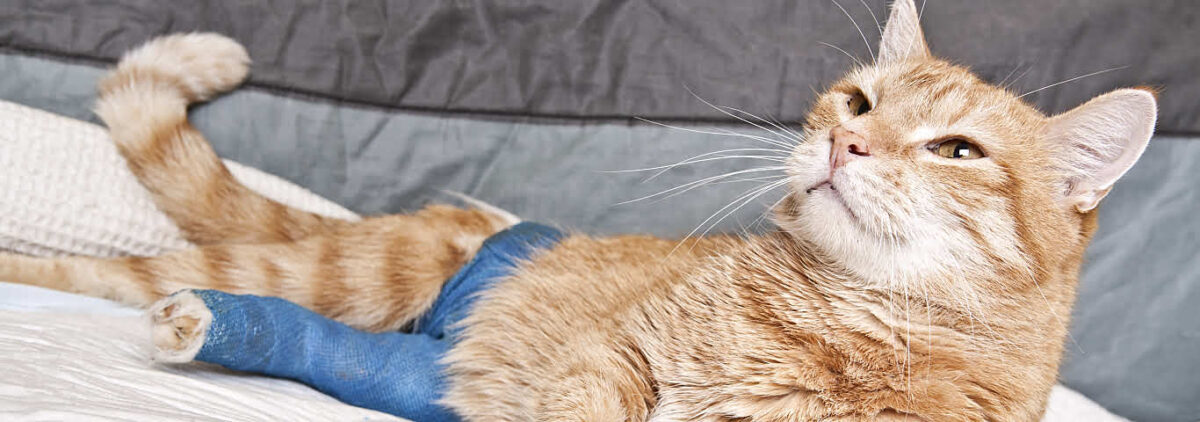Have you ever wondered how a street cat with a broken leg can still gracefully make its way through the streets? Or perhaps you’ve had a cat who broke a leg and were amazed at how they were able to conceal their pain so well. Cats are incredibly resilient creatures, and even with an untreated broken leg, they can appear almost normal. Humans would be bedridden for weeks under similar circumstances, but cats have a genetic advantage derived from their wild ancestry that allows them to manage pain effectively. This explains why a cat with a broken leg can continue hunting and scavenging despite a severe limb fracture.
Causes of Limb Fractures in Cats
Trauma is the most common cause of limb fractures in cats. Some common types of trauma include:
- Vehicular trauma: Being hit by a vehicle is the leading cause of fractures in cats.
- Bite wounds: Dog bites, in particular, can result in broken limbs.
- Projectile injuries: Injuries from bullets, arrows, slingshots, or pellet guns can easily fracture a cat’s limbs.
- High-rise syndrome: Falling from heights, such as balconies or rooftops, can cause fractures.
- Household injuries: Furniture and appliances in the house, such as reclining chairs, can lead to limb fractures in cats.
Aside from trauma, there are other non-traumatic reasons why a cat may suffer a limb fracture, including:
- Poor nutrition: Cats with nutritional deficiencies that weaken their bones are more prone to fractures.
- Infections: Certain infections can affect joint integrity or limb strength, making fractures more likely.
- Metabolic diseases: Problems like diabetes and excess weight increase the risk of fractures.
- Parathyroid disorders: Disruptions in the parathyroid hormone, which regulates minerals crucial for bone formation, can lead to fractures.
- Cancer: Cancerous bones are more susceptible to breakage.
When diagnosing a cat with a broken leg, all of these possibilities must be considered.
How to Identify if a Cat Has a Broken Leg
A cat with an untreated broken leg will typically exhibit symptoms such as noticeable limping. The limb may dangle as they walk, but some cats may still bear weight on the leg if the fracture is not severe enough to render it unstable.
Assessing pain in cats can be challenging. Cats are masters at hiding pain, as any sign of weakness makes them vulnerable to predators. Stress hormones also serve to alleviate some of the pain.
Other signs of a broken leg in a cat include swelling, damage to the skin, an unnatural angle to the limb, blood or discoloration at the site of injury, and “open” fractures where the skin near the injury is affected. Hiding behavior is also common, as cats instinctively hunker down to give their bodies a chance to heal. A normally social cat may distance themselves or exhibit aggressive behavior as they try to conceal their pain.
Diagnosis and Treatment
Diagnosing a broken leg in a cat often requires sedation and an X-ray for a definitive result. While an experienced veterinarian may be able to feel a fresh fracture, a cat with an untreated broken leg may have been healing for weeks before being examined.
Treatment of a broken leg will depend on the severity of the injury and whether the fracture is “open” or “closed.” Antibiotics and surgery are necessary for an open fracture.
Fractures can range from simple, uncomplicated fractures to complex, comminuted fractures with multiple bony pieces. Displaced fractures often require surgery to stabilize them, while nondisplaced fractures can heal well with splinting alone. Pain relief is always recommended unless the fracture is well-healed. This includes short-term pain medication such as anesthetics and opioids, as well as long-term anti-inflammatory pain medications.
In severe cases, amputation may be the best option. Cats are remarkably resilient and can adapt to life with a missing limb, often quickly regaining their normal behavior.
Home Care for a Cat With a Broken Leg
Restricted mobility, usually through cage rest, is essential for optimal healing. If surgery was performed, proper incision care is required. Pain medication and antibiotics may need to be administered orally or transdermally. A recovery collar and splint replacement may be necessary. Follow-up visits are crucial to monitor healing progress.
While it may initially seem overwhelming, taking care of a cat with a broken leg is manageable. Cats heal exceptionally well, both emotionally and physically.
The Role of Nutrition in Limb Fractures
Proper nutrition is crucial to maintaining optimal bone health and preventing fractures in cats. Imbalanced calcium and phosphorus intake can make cats more susceptible to limb fractures. Aftercare for limb fracture patients requires a delicate nutrient balance. Feeding your cat feline-specific food that is properly balanced is essential. It’s also important to avoid exposing cats recovering from trauma to additional stress by changing their food or feeding schedule.
Frequently Asked Questions
Coming soon…
Conclusion
Identifying a broken leg in a cat can be challenging, but with awareness of the symptoms and prompt veterinary care, cats can make a full recovery. Understanding the causes, diagnosis, and treatment options for broken legs in cats can help pet owners provide the necessary care and support for their furry friends. With proper nutrition and home care, cats can heal and regain their normal activities. Remember, if you suspect your cat has a broken leg, always consult a veterinarian for an accurate diagnosis and appropriate treatment.
